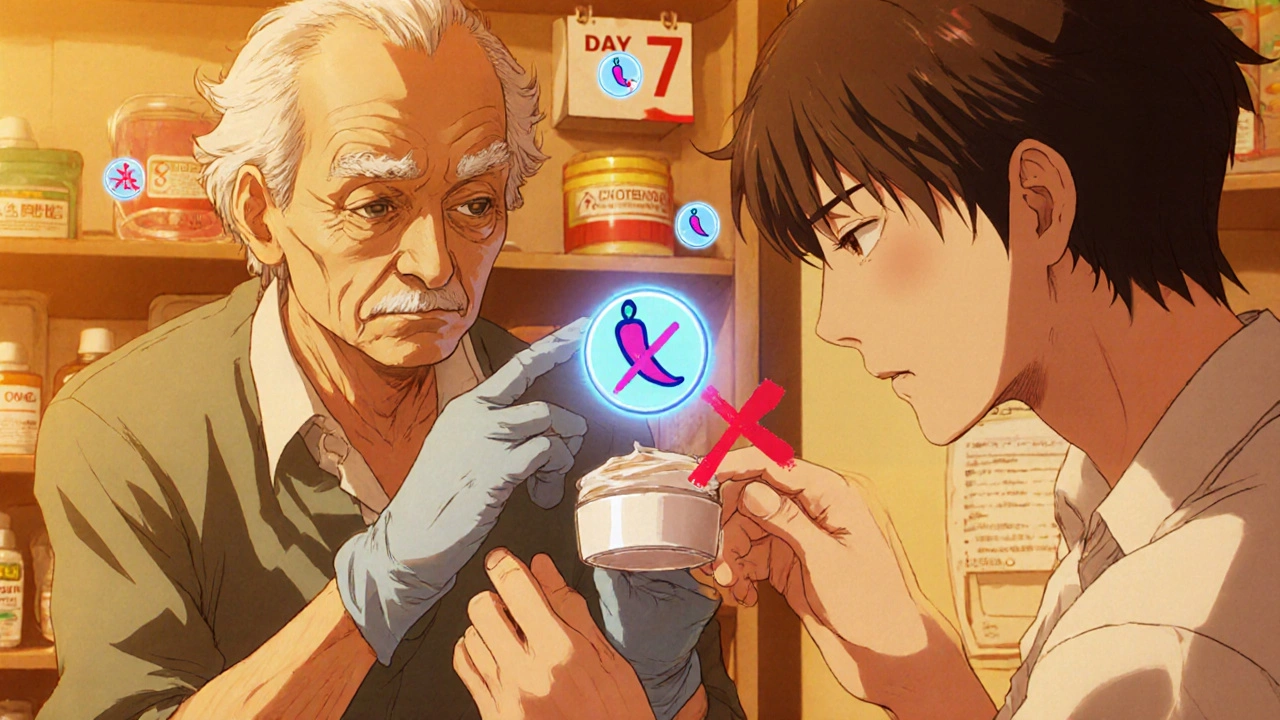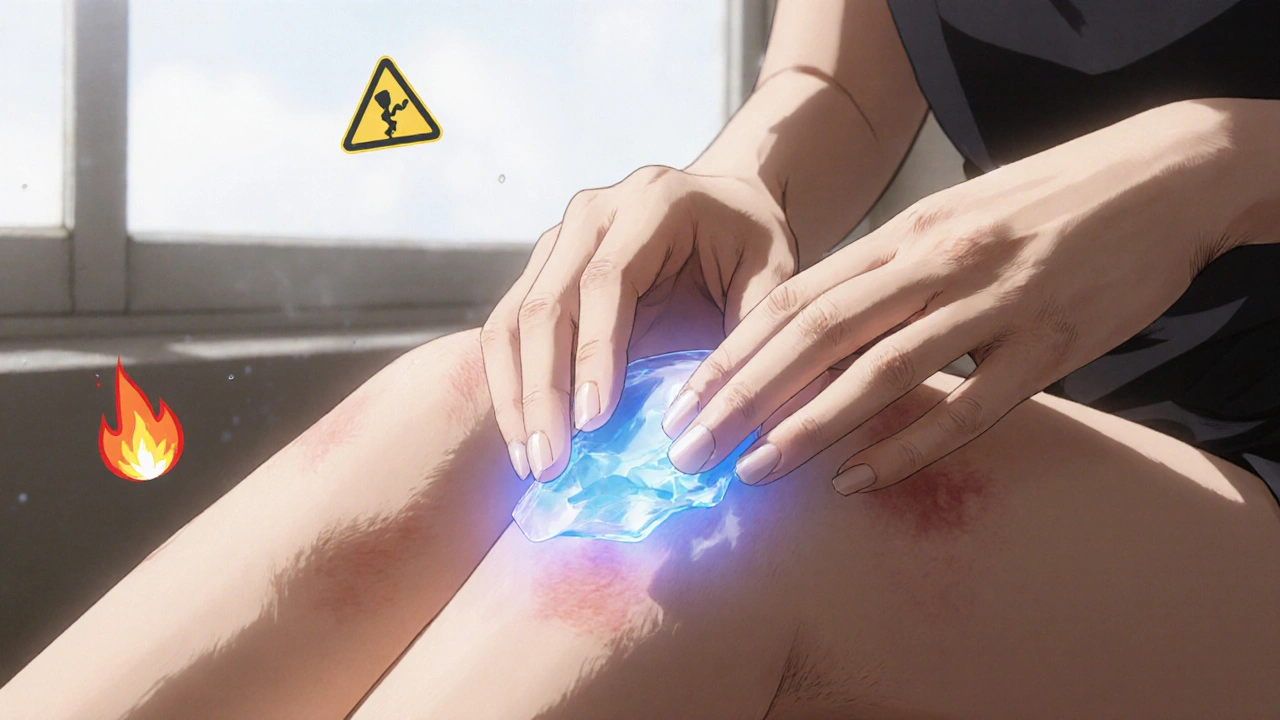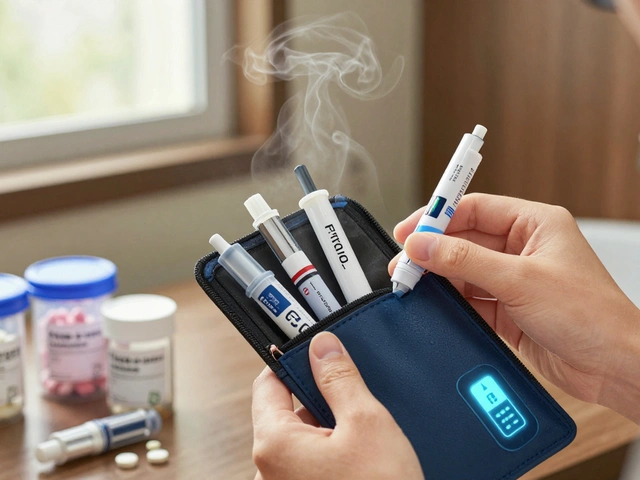Every year, millions of people reach for a cream, gel, or patch to ease sore muscles or achy joints. You don’t need a prescription. You don’t need to wait for a doctor’s appointment. You just grab it off the shelf-maybe Aspercreme, Icy Hot, or a capsaicin patch-and rub it on. It feels good. It works. But are you using it safely?
What’s Actually in These Products?
Not all topical pain relievers are the same. They work in different ways, and their ingredients carry different risks. The three most common active ingredients are menthol, methyl salicylate, and capsaicin. There’s also lidocaine, but that’s where things get dangerous.
Menthol gives that cooling, tingling sensation. It doesn’t reduce inflammation-it tricks your nerves into feeling less pain. Products like Aspercreme Heat Pain Relieving Gel contain exactly 10% menthol, which is the maximum allowed in OTC formulas. But here’s the catch: Health Canada found a clear link between menthol and rare but serious skin burns. These aren’t mild redness. These are actual chemical burns that can blister and scar. The risk isn’t common, but it’s real. That’s why Canadian labels now include a warning: Do not use with heating pads, hot water bottles, or on damaged skin.
Methyl salicylate is related to aspirin. It’s in products like Bengay and is used to reduce inflammation. Unlike menthol, there are no documented cases of serious burns from methyl salicylate alone. But if you’re allergic to aspirin or take blood thinners like warfarin, this ingredient can increase your risk of bleeding. It’s absorbed through the skin, even if you don’t feel it.
Capsaicin comes from chili peppers. It works by depleting a chemical in your nerves that sends pain signals. OTC creams usually have between 0.025% and 0.1% capsaicin. The catch? It burns-literally. When you first apply it, your skin will feel hot, even painful. That’s normal. But you need to wear gloves or use a roll-on applicator. One touch to your eye after applying capsaicin can mean hours of agony. You also need to use it consistently-three or four times a day-for up to a week before you feel real relief.
The Lidocaine Danger Zone
In July 2023, the FDA issued a sharp warning: stop using certain topical pain products sold for cosmetic procedures. These weren’t ordinary creams. They were illegally made with lidocaine concentrations as high as 20%. The legal limit for OTC products is 4%. These high-dose products were marketed for use before laser hair removal, microdermabrasion, or tattoos. The problem? When you apply them to freshly abraded or broken skin during these procedures, your body absorbs way too much lidocaine.
Too much lidocaine can cause seizures, irregular heartbeat, and trouble breathing. The FDA named six companies-Bella’s Beauty Supply, DermaRoller Store, DermaSelect, DermaWand, DermaFlash, and DermaSweep-for selling these dangerous products. They’ve been warned. They’ve been targeted. But they’re still out there, sold online and in some beauty shops. If a product promises to numb you for a tattoo or laser treatment and doesn’t list the lidocaine percentage, walk away.
What You Should Never Do
Even safe products become risky when misused. Here are the top mistakes people make:
- Don’t use them on broken, cut, or sunburned skin. Your skin is a barrier. When it’s damaged, chemicals enter your bloodstream faster and in higher amounts. This is how menthol causes burns and how lidocaine can poison you.
- Never combine them with heat. Heating pads, hot showers, or electric blankets increase blood flow to the area. That means more of the drug gets absorbed. Heat + menthol = burn risk. Heat + methyl salicylate = higher chance of systemic side effects.
- Avoid covering them with tight bandages. Occlusive dressings (like plastic wrap) trap the product against your skin and boost absorption. That’s how a harmless cream turns into a medical emergency.
- Keep them away from eyes, nose, and mouth. Capsaicin and menthol can cause severe irritation. Wash your hands immediately after applying. If you accidentally get it in your eye, rinse with cool water for at least 15 minutes and call poison control.
- Don’t use them for more than 7 days without checking in with a doctor. If pain doesn’t improve in a week, it’s not a simple muscle strain. It could be something serious.

Who Should Avoid These Products?
Some people are at higher risk-even with normal use.
- People with aspirin allergies or on blood thinners. Methyl salicylate and diclofenac (another topical NSAID) can interfere with clotting. Talk to your pharmacist before using them.
- People with kidney disease. Even topical NSAIDs like diclofenac can affect kidney function if used daily over long periods. The amount absorbed is small, but it adds up.
- Pregnant women. While topical NSAIDs are generally considered lower risk than pills, there’s limited data. Always check with your OB-GYN before using.
- Children under 12. Their skin is thinner and absorbs more. Most products aren’t tested or approved for young kids.
Why Topical Is Safer Than Pills
Compared to taking ibuprofen or naproxen every day, topical pain relievers have a major advantage: less goes into your bloodstream. Harvard Health Publishing points out that topical creams deliver smaller doses to the affected area, meaning fewer side effects on your stomach, kidneys, and heart.
Oral NSAIDs cause gastrointestinal bleeding in about 1-2% of regular users. They can raise blood pressure and worsen kidney disease. Topical versions? The risk is dramatically lower. That’s why doctors often recommend them first for osteoarthritis in the knee or hand, or for minor sprains.
But don’t assume they’re risk-free. The Cleveland Clinic warns that even topical pain relievers can cause side effects if you use them too often, too long, or in large amounts. Tolerance can develop-you might need more to get the same effect. That’s a red flag to stop and see a doctor.

How to Use Them Right
Here’s a simple, safe routine:
- Check the label. Know what’s in it-menthol, capsaicin, lidocaine? Know the concentration.
- Use only on healthy, intact skin. No cuts, rashes, or sunburns.
- Wash your hands before and after. Use gloves or a roller for capsaicin.
- Apply a thin layer. More doesn’t mean better.
- Wait at least 30 minutes before showering or putting on clothes.
- Don’t use with heat sources or bandages.
- Stop if you get redness, itching, or burning that doesn’t go away.
- Don’t use longer than 7 days unless your doctor says so.
What to Do If Something Goes Wrong
If you notice:
- Blistering, peeling, or darkening of skin after using a menthol product → Call your doctor or go to urgent care.
- Dizziness, rapid heartbeat, or trouble breathing after using a lidocaine product → Call 911 or poison control immediately.
- Severe eye irritation after touching capsaicin → Rinse with water for 15 minutes and seek medical help.
Don’t wait. Even if you think it’s “just a burn,” it could be a sign of deeper damage.
Final Thought: OTC Doesn’t Mean Risk-Free
Just because you can buy it without a prescription doesn’t mean it’s harmless. The Mayo Clinic reminds us that many people assume OTC means “safe to use however I want.” That’s not true. Menthol burns, lidocaine overdoses, and capsaicin eye injuries are all real-and preventable.
The best way to stay safe? Know what you’re using. Read the label. Follow the instructions. And if you’re unsure, ask your pharmacist. They’re trained to catch interactions and risks you might miss.
Topical pain relievers can be a great tool. But like any tool, they’re only safe when used the right way.
Can I use OTC topical pain relievers every day?
Most OTC topical pain relievers are meant for short-term use-no more than 7 days in a row. Using them daily for weeks or months can lead to skin irritation, reduced effectiveness (tolerance), or even systemic side effects, especially with NSAID-based products like diclofenac. If your pain lasts longer than a week, see a doctor. It’s not a sign the cream isn’t working-it’s a sign you need a different approach.
Is capsaicin cream safe for long-term use?
Yes, capsaicin can be used long-term if you tolerate it well. It doesn’t cause dependence or liver damage like some oral medications. But you need to use it consistently-three to four times a day-to maintain relief. The initial burning sensation usually fades after a few days. Always wear gloves or use a roller when applying, and never touch your face or eyes afterward. If you develop a rash or worsening pain, stop and consult a healthcare provider.
Are menthol creams dangerous for seniors?
Seniors are at higher risk because their skin is thinner and more sensitive. Menthol can cause burns more easily, especially if they’re using heating pads for arthritis or have reduced sensation from diabetes or nerve damage. Health Canada’s warnings apply to everyone, but older adults should be extra cautious. Always apply a small test patch first, avoid heat, and check with a pharmacist before using any new product.
Can I use topical pain relievers with oral painkillers?
Yes, but with caution. Combining topical NSAIDs like diclofenac with oral ibuprofen or naproxen increases your total NSAID exposure, raising the risk of stomach ulcers, kidney issues, and high blood pressure. If you’re taking blood thinners, avoid methyl salicylate altogether. Always check with your pharmacist before mixing any OTC products. They can spot hidden overlaps you might miss.
How do I know if a lidocaine product is legal?
Check the label. Legal OTC lidocaine products must list the concentration-and it must be 4% or less. If the label says “maximum strength,” “professional grade,” or “for cosmetic use,” be suspicious. Products sold online for tattoos, laser hair removal, or microdermabrasion with no listed percentage are almost certainly illegal. The FDA has warned about specific brands like DermaWand and DermaFlash. If you’re unsure, don’t buy it.
Do topical pain relievers really work for arthritis?
Yes, for mild to moderate osteoarthritis in joints close to the skin-like hands, knees, or elbows. Studies show capsaicin and topical NSAIDs like diclofenac gel can be as effective as oral pills for localized pain, with far fewer side effects. They won’t cure arthritis or reverse joint damage, but they can help you move better and reduce daily discomfort. They’re often recommended as a first-line treatment by rheumatologists.





james lucas
November 23, 2025 AT 02:04i used that menthol gel last winter after skiing and thought it was magic until my knee started looking like a science experiment. i didnt even use a heating pad, just sat on the couch with socks on and boom-burn. i thought it was just redness but it blistered. now i read labels like im decoding a bomb manual. health canada was right to warn people, this stuff is sneaky
Jessica Correa
November 24, 2025 AT 10:41capsaicin is the real villain in disguise i swear i cried the first time i used it and now i cant live without it for my lower back but please please please wash your hands and dont touch your face even if you think youre careful its a nightmare
manish chaturvedi
November 25, 2025 AT 04:45In my country, we have used herbal pastes for joint pain for generations. But modern products like these, with concentrated chemicals, require caution. I have seen elderly relatives suffer skin damage from overuse. It is not just about the ingredient-it is about how we treat our bodies. Respect the product, respect your skin. A little knowledge goes a long way.
Nikhil Chaurasia
November 25, 2025 AT 06:41the lidocaine thing scared me so bad i deleted three apps off my phone. i was about to order that "dermaflash" thing for my tattoo prep. i thought it was just hype. now i know better. if it sounds too good to be true and comes with a fancy name and no dosage? run. i almost became a statistic
Michael Fitzpatrick
November 26, 2025 AT 13:53just wanted to say this is one of the most helpful posts i’ve read in months. i’ve been using diclofenac gel for my knee arthritis for over a year and never thought twice about it until now. i had no idea it could affect my kidneys over time. i’m going to my pharmacist tomorrow to get checked out. thank you for the clarity and the warnings. this isn’t just info-it’s a lifeline for people like me who just want to move without pain
Shawn Daughhetee
November 26, 2025 AT 15:39my mom used to slap on that icy hot like it was lotion and then put a heating pad on top. i used to think it was funny until she got a third degree burn on her hip. now i check her meds every week. dont be like my mom. read the damn label
Melvina Zelee
November 26, 2025 AT 20:19people treat otc like it means "oh this is totally chill" but its just a fancy way of saying "we dont have to test this as hard as prescription stuff". the fact that you can buy 10% menthol off a shelf is wild. imagine if you could buy 10% cocaine off a shelf. we’d be in an uproar. but skin burns? eh, its just a burn. we need better labeling. better education. and maybe a warning video before you check out at cvs
steve o'connor
November 27, 2025 AT 21:14as someone who’s used capsaicin for years, i can confirm: the first week is hell. but after that, it’s like your nerves forget how to scream. i use it for sciatica and it’s the only thing that gives me real relief. just wear gloves. always. even if you’re in a hurry. trust me, you don’t want to rub your eye after applying this
Robin Johnson
November 28, 2025 AT 08:28if you’re using these daily for more than a week, you’re not treating pain-you’re masking a problem. your body is screaming for help and you’re giving it a bandaid made of chemicals. i’ve seen too many people delay real treatment because they thought the cream was "fixing" it. see a doctor. get an xray. figure out why it hurts. the cream is a tool, not a solution
Miruna Alexandru
November 28, 2025 AT 19:05the author conveniently omits that methyl salicylate is a prodrug of salicylic acid, which is metabolized similarly to aspirin. systemic absorption can lead to salicylate toxicity even without ingestion, especially in elderly patients with reduced renal clearance. the fact that this is not emphasized in consumer-facing materials is a regulatory failure. this is not a "safety guide"-it’s a public health oversight disguised as helpful advice.
ann smith
November 29, 2025 AT 01:07thank you for this!! <3 i’ve been using capsaicin for my hands and it’s been a game changer. i always wash my hands after and use the roller. i even bought extra gloves just for it. you’re right-this stuff works, but only if you treat it with respect. you’re not just helping yourself-you’re helping others who might not know the risks. big hug to you for writing this <3